ECU MAZDA MODEL CX-5 2015 (in English) User Guide
[x] Cancel search | Manufacturer: MAZDA, Model Year: 2015, Model line: MODEL CX-5, Model: MAZDA MODEL CX-5 2015Pages: 532, PDF Size: 8 MB
Page 45 of 532
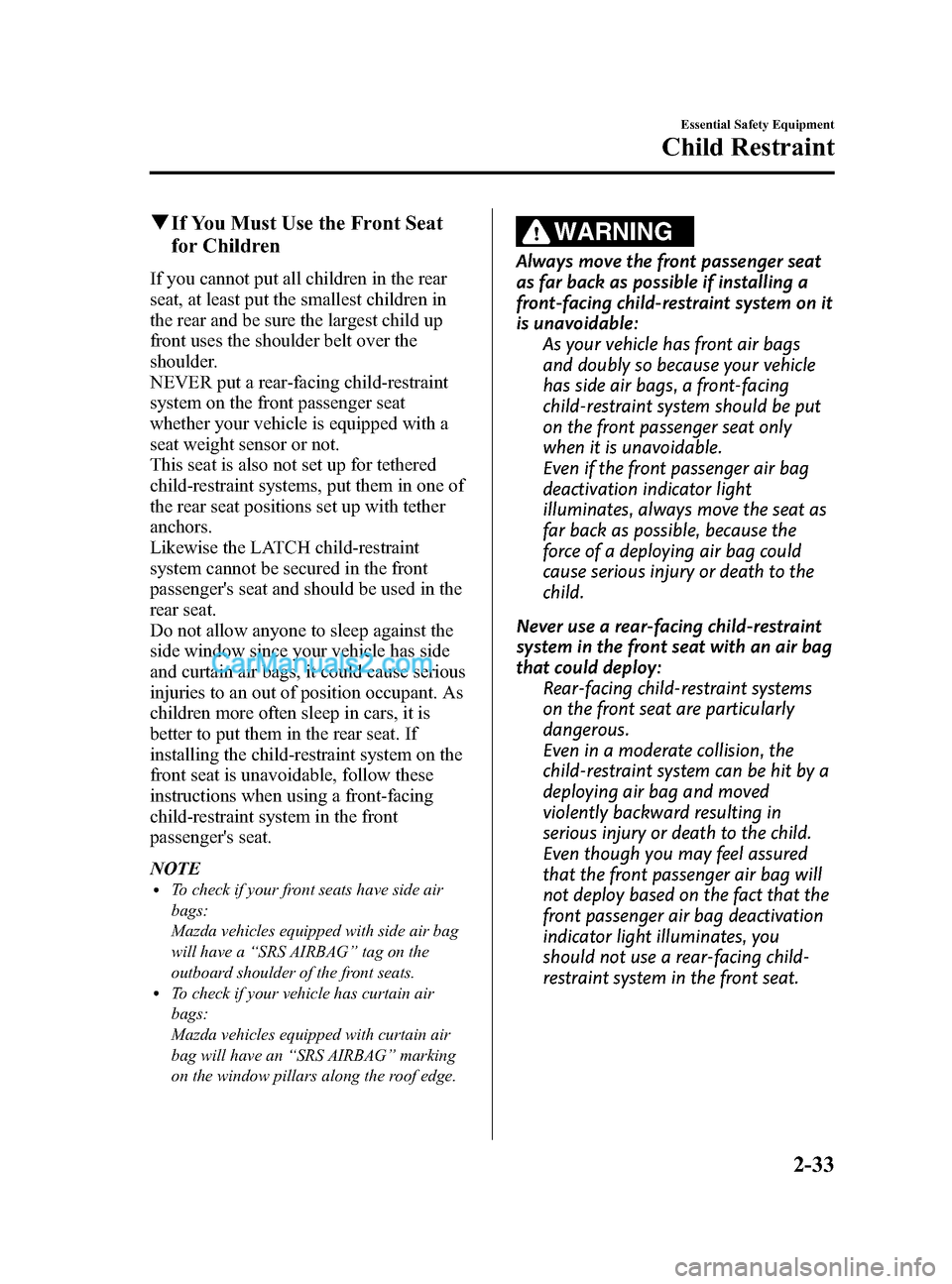
Black plate (45,1)
qIf You Must Use the Front Seat
for Children
If you cannot put all children in the rear
seat, at least put the smallest children in
the rear and be sure the largest child up
front uses the shoulder belt over the
shoulder.
NEVER put a rear-facing child-restraint
system on the front passenger seat
whether your vehicle is equipped with a
seat weight sensor or not.
This seat is also not set up for tethered
child-restraint systems, put them in one of
the rear seat positions set up with tether
anchors.
Likewise the LATCH child-restraint
system cannot be secured in the front
passenger's seat and should be used in the
rear seat.
Do not allow anyone to sleep against the
side window since your vehicle has side
and curtain air bags, it could cause serious
injuries to an out of position occupant. As
children more often sleep in cars, it is
better to put them in the rear seat. If
installing the child-restraint system on the
front seat is unavoidable, follow these
instructions when using a front-facing
child-restraint system in the front
passenger's seat.
NOTE
lTo check if your front seats have side air
bags:
Mazda vehicles equipped with side air bag
will have a “SRS AIRBAG ”tag on the
outboard shoulder of the front seats.
lTo check if your vehicle has curtain air
bags:
Mazda vehicles equipped with curtain air
bag will have an “SRS AIRBAG ”marking
on the window pillars along the roof edge.
WARNING
Always move the front passenger seat
as far back as possible if installing a
front-facing child-restraint system on it
is unavoidable: As your vehicle has front air bags
and doubly so because your vehicle
has side air bags, a front-facing
child-restraint system should be put
on the front passenger seat only
when it is unavoidable.
Even if the front passenger air bag
deactivation indicator light
illuminates, always move the seat as
far back as possible, because the
force of a deploying air bag could
cause serious injury or death to the
child.
Never use a rear-facing child-restraint
system in the front seat with an air bag
that could deploy: Rear-facing child-restraint systems
on the front seat are particularly
dangerous.
Even in a moderate collision, the
child-restraint system can be hit by a
deploying air bag and moved
violently backward resulting in
serious injury or death to the child.
Even though you may feel assured
that the front passenger air bag will
not deploy based on the fact that the
front passenger air bag deactivation
indicator light illuminates, you
should not use a rear-facing child-
restraint system in the front seat.
Essential Safety Equipment
Child Restraint
2-33
CX-5_8DR2-EA-14A_Edition1 Page45
Thursday, November 21 2013 8:48 AM
Form No.8DR2-EA-14A
Page 47 of 532
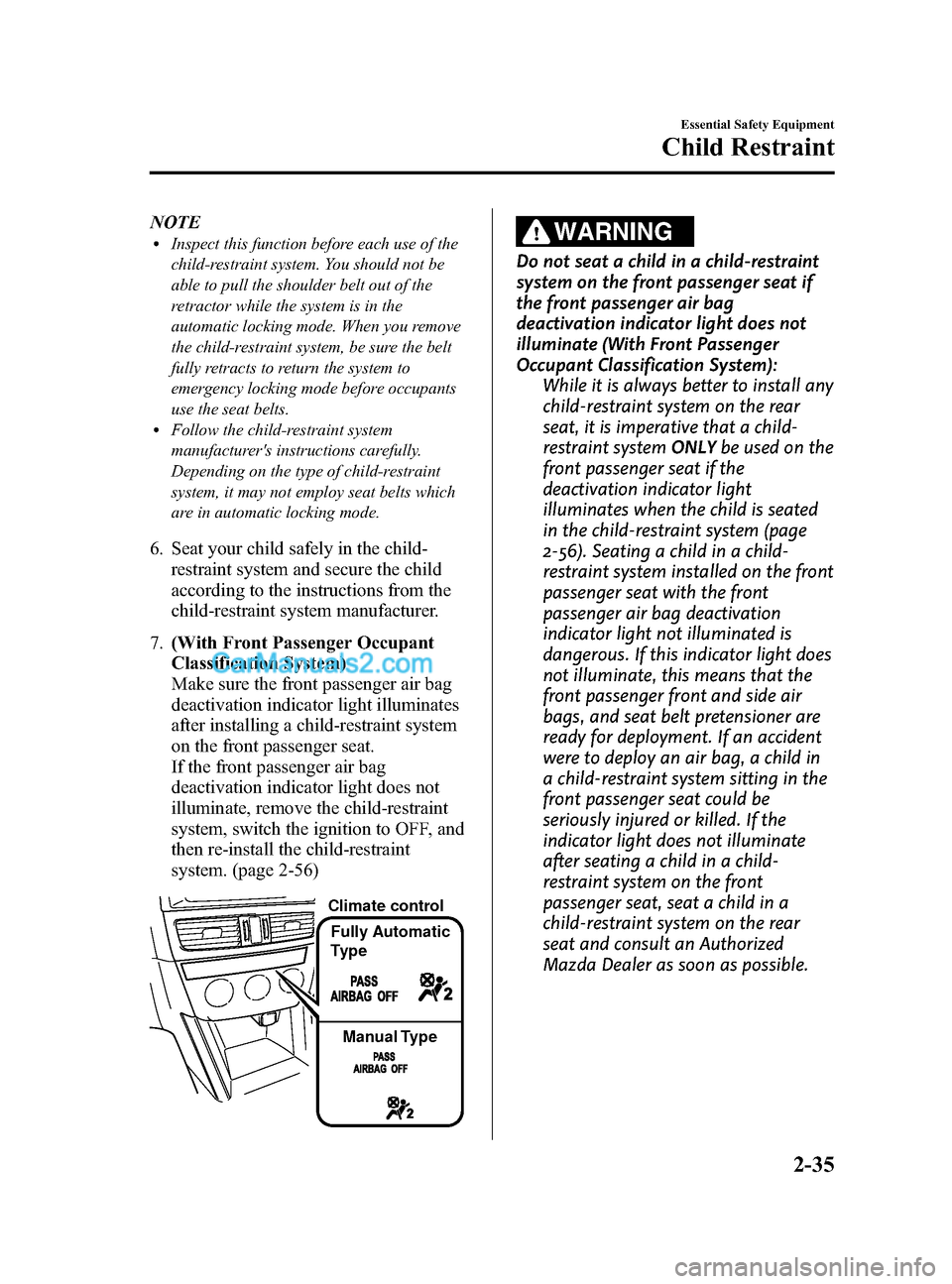
Black plate (47,1)
NOTElInspect this function before each use of the
child-restraint system. You should not be
able to pull the shoulder belt out of the
retractor while the system is in the
automatic locking mode. When you remove
the child-restraint system, be sure the belt
fully retracts to return the system to
emergency locking mode before occupants
use the seat belts.
lFollow the child-restraint system
manufacturer's instructions carefully.
Depending on the type of child-restraint
system, it may not employ seat belts which
are in automatic locking mode.
6. Seat your child safely in the child-restraint system and secure the child
according to the instructions from the
child-restraint system manufacturer.
7. (With Front Passenger Occupant
Classification System)
Make sure the front passenger air bag
deactivation indicator light illuminates
after installing a child-restraint system
on the front passenger seat.
If the front passenger air bag
deactivation indicator light does not
illuminate, remove the child-restraint
system, switch the ignition to OFF, and
then re-install the child-restraint
system. (page 2-56)
Climate control
Fully Automatic
Type
Manual Type
WARNING
Do not seat a child in a child-restraint
system on the front passenger seat if
the front passenger air bag
deactivation indicator light does not
illuminate (With Front Passenger
Occupant Classification System): While it is always better to install any
child-restraint system on the rear
seat, it is imperative that a child-
restraint system ONLYbe used on the
front passenger seat if the
deactivation indicator light
illuminates when the child is seated
in the child-restraint system (page
2-56). Seating a child in a child-
restraint system installed on the front
passenger seat with the front
passenger air bag deactivation
indicator light not illuminated is
dangerous. If this indicator light does
not illuminate, this means that the
front passenger front and side air
bags, and seat belt pretensioner are
ready for deployment. If an accident
were to deploy an air bag, a child in
a child-restraint system sitting in the
front passenger seat could be
seriously injured or killed. If the
indicator light does not illuminate
after seating a child in a child-
restraint system on the front
passenger seat, seat a child in a
child-restraint system on the rear
seat and consult an Authorized
Mazda Dealer as soon as possible.
Essential Safety Equipment
Child Restraint
2-35
CX-5_8DR2-EA-14A_Edition1 Page47
Thursday, November 21 2013 8:48 AM
Form No.8DR2-EA-14A
Page 48 of 532
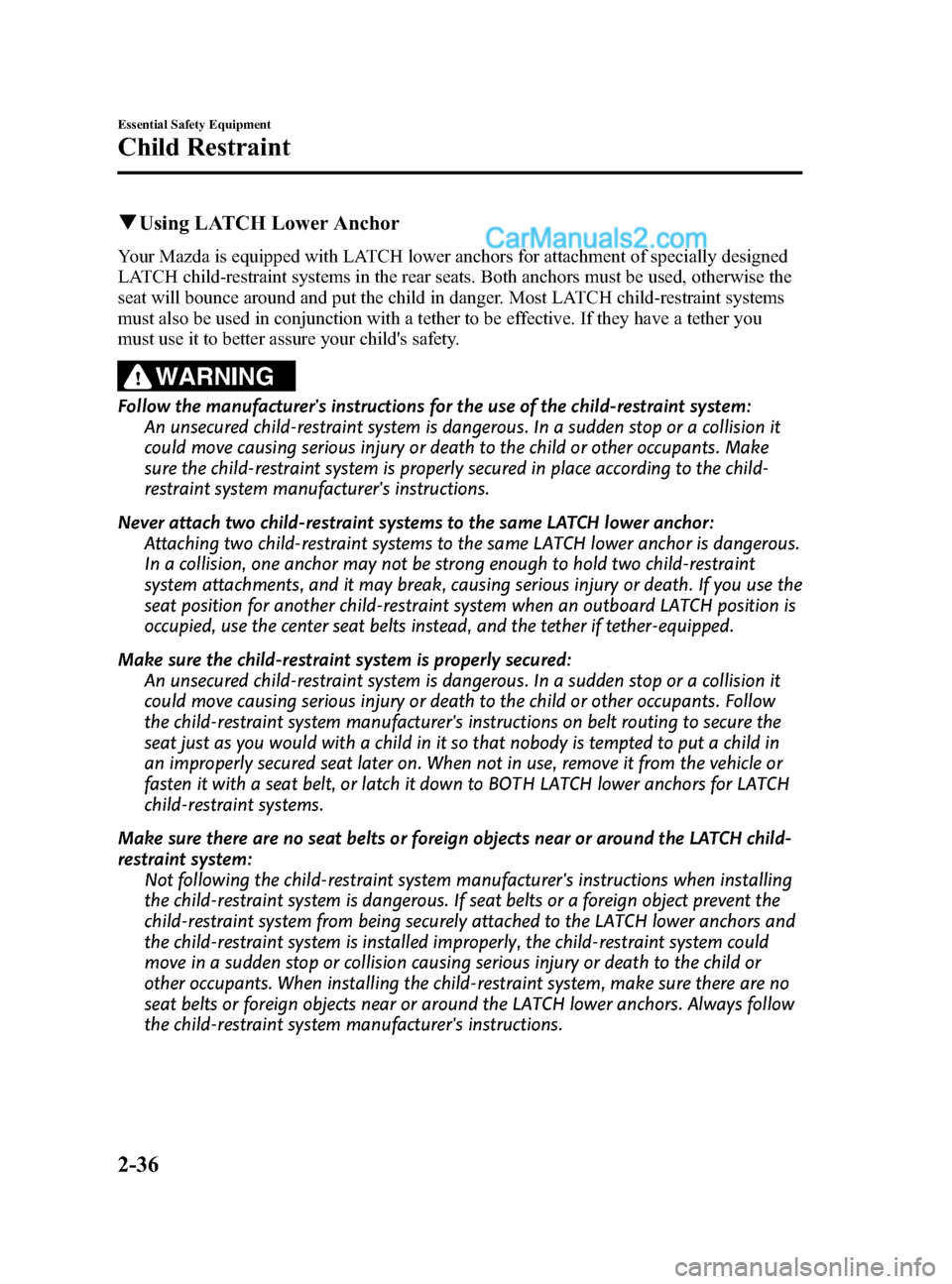
Black plate (48,1)
qUsing LATCH Lower Anchor
Your Mazda is equipped with LATCH lower anchors for attachment of specially designed
LATCH child-restraint systems in the rear seats. Both anchors must be used, otherwise the
seat will bounce around and put the child in danger. Most LATCH child-restraint systems
must also be used in conjunction with a tether to be effective. If they have a tether you
must use it to better assure your child's safety.
WARNING
Follow the manufacturer's instructions for the use of the child-restraint system:
An unsecured child-restraint system is dangerous. In a sudden stop or a collision it
could move causing serious injury or death to the child or other occupants. Make
sure the child-restraint system is properly secured in place according to the child-
restraint system manufacturer's instructions.
Never attach two child-restraint systems to the same LATCH lower anchor: Attaching two child-restraint systems to the same LATCH lower anchor is dangerous.
In a collision, one anchor may not be strong enough to hold two child-restraint
system attachments, and it may break, causing serious injury or death. If you use the
seat position for another child-restraint system when an outboard LATCH position is
occupied, use the center seat belts instead, and the tether if tether-equipped.
Make sure the child-restraint system is properly secured: An unsecured child-restraint system is dangerous. In a sudden stop or a collision it
could move causing serious injury or death to the child or other occupants. Follow
the child-restraint system manufacturer's instructions on belt routing to secure the
seat just as you would with a child in it so that nobody is tempted to put a child in
an improperly secured seat later on. When not in use, remove it from the vehicle or
fasten it with a seat belt, or latch it down to BOTH LATCH lower anchors for LATCH
child-restraint systems.
Make sure there are no seat belts or foreign objects near or around the LATCH child-
restraint system: Not following the child-restraint system manufacturer's instructions when installing
the child-restraint system is dangerous. If seat belts or a foreign object prevent the
child-restraint system from being securely attached to the LATCH lower anchors and
the child-restraint system is installed improperly, the child-restraint system could
move in a sudden stop or collision causing serious injury or death to the child or
other occupants. When installing the child-restraint system, make sure there are no
seat belts or foreign objects near or around the LATCH lower anchors. Always follow
the child-restraint system manufacturer's instructions.
2-36
Essential Safety Equipment
Child Restraint
CX-5_8DR2-EA-14A_Edition1 Page48
Thursday, November 21 2013 8:48 AM
Form No.8DR2-EA-14A
Page 49 of 532
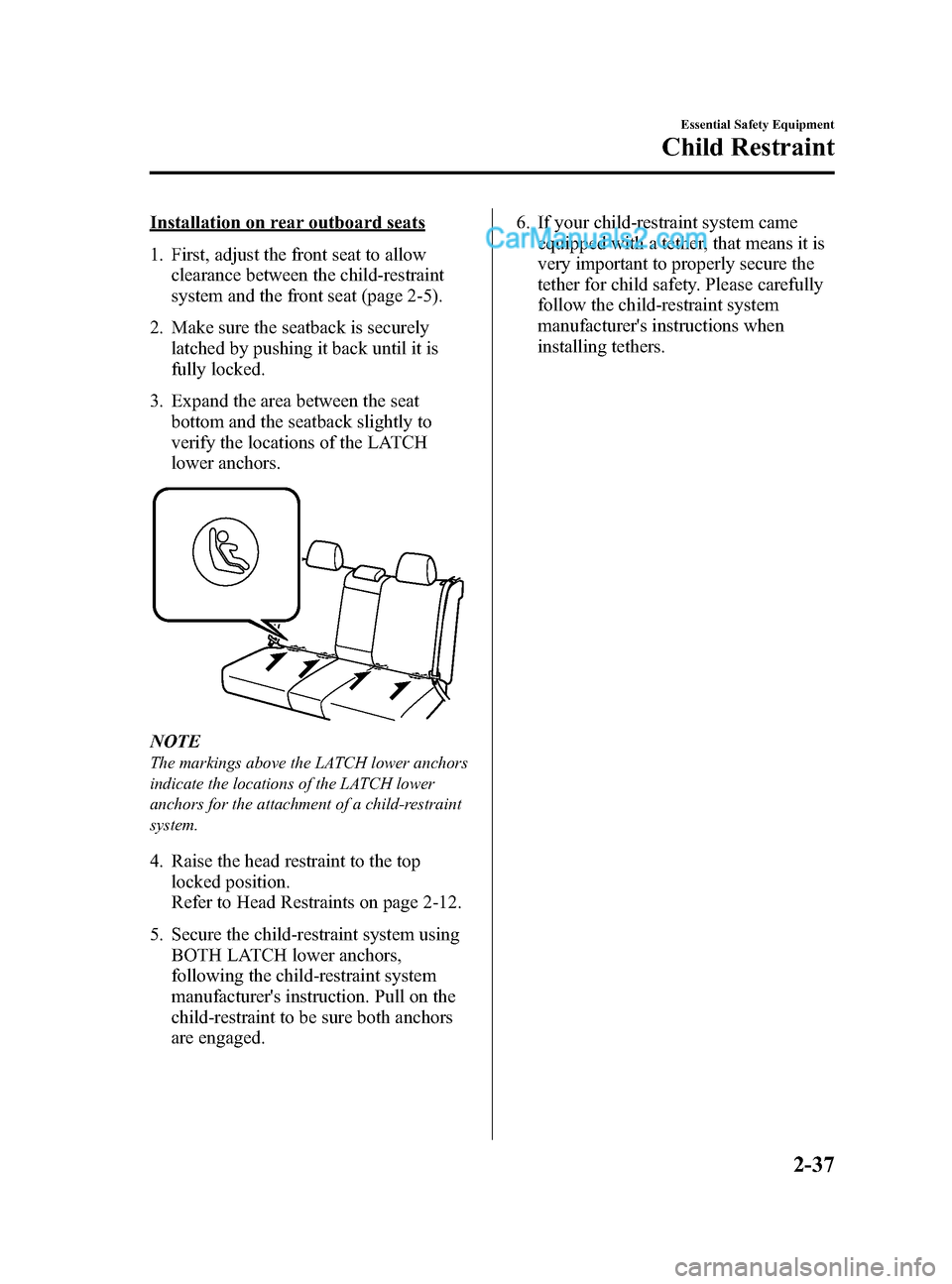
Black plate (49,1)
Installation on rear outboard seats
1. First, adjust the front seat to allowclearance between the child-restraint
system and the front seat (page 2-5).
2. Make sure the seatback is securely latched by pushing it back until it is
fully locked.
3. Expand the area between the seat bottom and the seatback slightly to
verify the locations of the LATCH
lower anchors.
NOTE
The markings above the LATCH lower anchors
indicate the locations of the LATCH lower
anchors for the attachment of a child-restraint
system.
4. Raise the head restraint to the toplocked position.
Refer to Head Restraints on page 2-12.
5. Secure the child-restraint system using BOTH LATCH lower anchors,
following the child-restraint system
manufacturer's instruction. Pull on the
child-restraint to be sure both anchors
are engaged. 6. If your child-restraint system came
equipped with a tether, that means it is
very important to properly secure the
tether for child safety. Please carefully
follow the child-restraint system
manufacturer's instructions when
installing tethers.
Essential Safety Equipment
Child Restraint
2-37
CX-5_8DR2-EA-14A_Edition1 Page49
Thursday, November 21 2013 8:48 AM
Form No.8DR2-EA-14A
Page 50 of 532
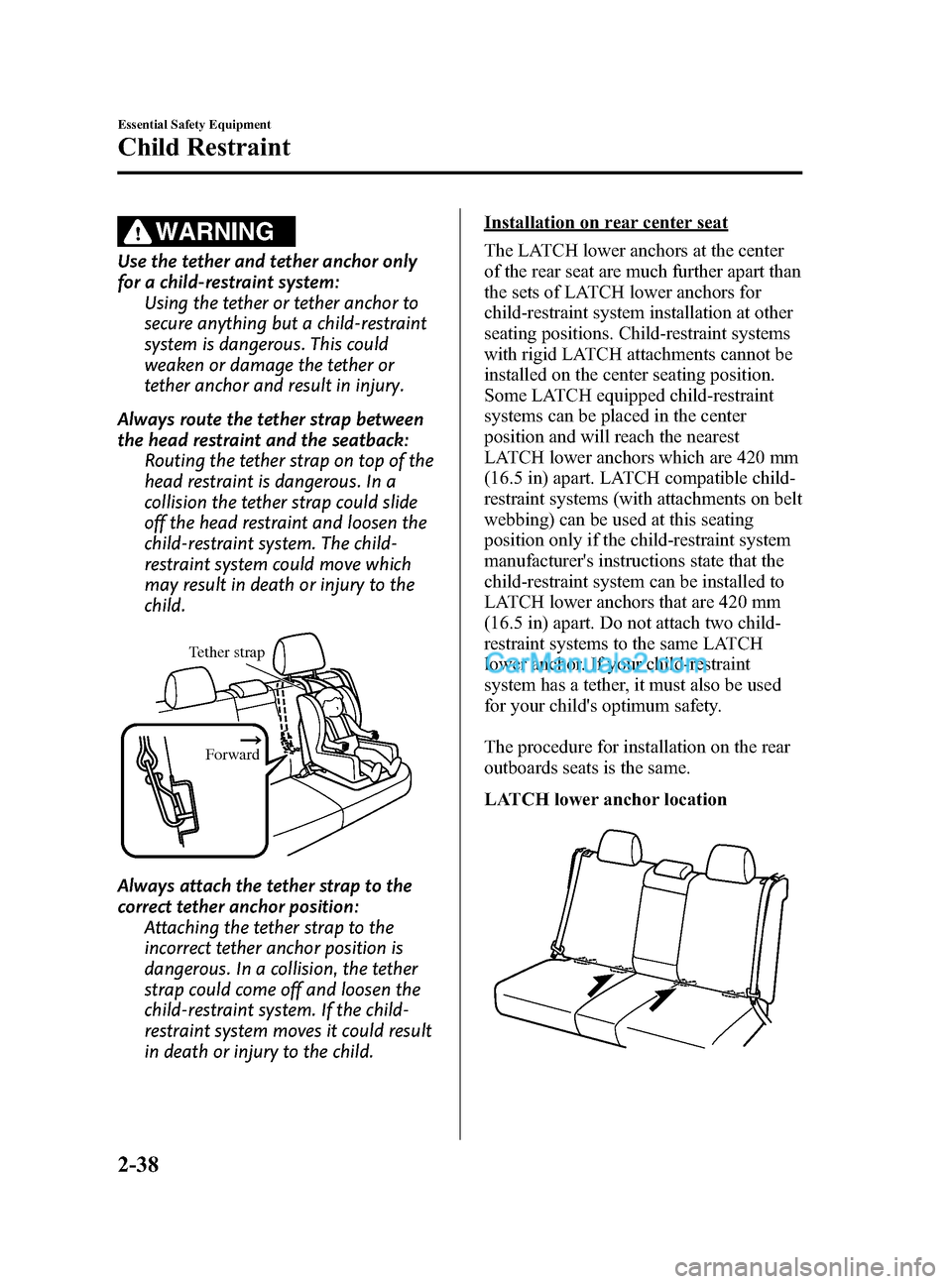
Black plate (50,1)
WARNING
Use the tether and tether anchor only
for a child-restraint system:Using the tether or tether anchor to
secure anything but a child-restraint
system is dangerous. This could
weaken or damage the tether or
tether anchor and result in injury.
Always route the tether strap between
the head restraint and the seatback: Routing the tether strap on top of the
head restraint is dangerous. In a
collision the tether strap could slide
off the head restraint and loosen the
child-restraint system. The child-
restraint system could move which
may result in death or injury to the
child.
Tether strap
Forward
Always attach the tether strap to the
correct tether anchor position: Attaching the tether strap to the
incorrect tether anchor position is
dangerous. In a collision, the tether
strap could come off and loosen the
child-restraint system. If the child-
restraint system moves it could result
in death or injury to the child.
Installation on rear center seat
The LATCH lower anchors at the center
of the rear seat are much further apart than
the sets of LATCH lower anchors for
child-restraint system installation at other
seating positions. Child-restraint systems
with rigid LATCH attachments cannot be
installed on the center seating position.
Some LATCH equipped child-restraint
systems can be placed in the center
position and will reach the nearest
LATCH lower anchors which are 420 mm
(16.5 in) apart. LATCH compatible child-
restraint systems (with attachments on belt
webbing) can be used at this seating
position only if the child-restraint system
manufacturer's instructions state that the
child-restraint system can be installed to
LATCH lower anchors that are 420 mm
(16.5 in) apart. Do not attach two child-
restraint systems to the same LATCH
lower anchor. If your child-restraint
system has a tether, it must also be used
for your child's optimum safety.
The procedure for installation on the rear
outboards seats is the same.
LATCH lower anchor location
2-38
Essential Safety Equipment
Child Restraint
CX-5_8DR2-EA-14A_Edition1 Page50
Thursday, November 21 2013 8:48 AM
Form No.8DR2-EA-14A
Page 53 of 532

Black plate (53,1)
If your vehicle is also equipped with a front passenger occupant classification system,
refer to the Front Passenger Occupant Classification System (page 2-56) for details.
If your vehicle is equipped with a front passenger occupant classification system, the front
passenger air bag deactivation indicator light illuminates for a specified time after the
ignition is switched ON.
Climate controlFully Automatic
Type
Manual Type
Small children must be protected by a child-restraint system as stipulated by law in every
state and province. In certain states and provinces, larger children must use a child-restraint
system (page 2-23).
Carefully consider which child-restraint system is necessary for your child and follow the
installation directions in this Owner's Manual as well as the child-restraint system
manufacturer's instructions.
WARNING
Seat belts must be worn in air bag equipped vehicles: Depending only on the air bags for protection during an accident is dangerous.
Alone, air bags may not prevent serious injuries. The appropriate air bags can be
expected to inflate only in the first accident, such as frontal, near frontal or side
collisions or roll-over accident that are at least moderate. Vehicle occupants should
always wear seat belts.
Children should not ride in the front passenger seat: Placing a child, 12 years or under, in the front seat is dangerous. The child could be
hit by a deploying air bag and be seriously injured or even killed. A sleeping child is
more likely to lean against the door and be hit by the side air bag in moderate
collision to the front-passenger side of the vehicle. Whenever possible, always secure
a child 12 years and under on the rear seats with an appropriate child-restraint
system for the child's age and size.
Essential Safety Equipment
SRS Air Bags
2-41
CX-5_8DR2-EA-14A_Edition1 Page53
Thursday, November 21 2013 8:48 AM
Form No.8DR2-EA-14A
Page 72 of 532

Black plate (72,1)
Do not increase the total seated weight on the front passenger seat:When an infant or small child sits on the front passenger seat, increasing the total
seated weight on the front passenger seat is dangerous. The front passenger seat
weight sensors will detect the increased total seated weight, which could result in the
unexpected deployment of the front passenger front and side air bags and seat belt
pretensioner system in an accident and may cause serious injury. Increasing the total
seated weight on the front passenger seat could result in the front passenger front
and side air bags and seat belt pretensioner system deployment in an accident under
the following conditions, for example:
ØLuggage or other items are placed on the seat with the child in the child-restraint
system.
Ø A rear passenger or luggage push or pull down on the front passenger seatback.
Ø A rear passenger steps on the front passenger seat rails with their feet.
Ø Luggage or other items are placed on the seatback or hung on the head restraint.
Ø Heavy items are placed in the seatback map pocket.
Ø The seat is washed.
Ø Liquids are spilled on the seat.
Ø The front passenger seat is moved backward, pushing into luggage or other items
placed behind it.
Ø The front passenger seatback contacts the rear seat.
Ø Luggage or other items are placed between the front passenger seat and driver
seat.
Ø Any accessories which might increase the total seated weight on the front
passenger seat are attached to the front passenger seat.
CAUTION
ØTo assure proper deployment of the front air bag and to prevent damage to the
sensors in the front seat bottoms:
ØDo not place sharp objects on the front seat bottoms or leave heavy luggage on
them.
ØDo not spill any liquids on the front seats or under the front seats.
Ø To allow the sensors to function properly, always perform the following:
ØAdjust the front seats as far back as possible and always sit upright against the
seatbacks with seat belts worn properly.
ØIf you place your child on the front passenger seat, secure the child-restraint
system properly and slide the front passenger seat as far back as possible (page
2-31).
2-60
Essential Safety Equipment
SRS Air Bags
CX-5_8DR2-EA-14A_Edition1 Page72
Thursday, November 21 2013 8:48 AM
Form No.8DR2-EA-14A
Page 73 of 532

Black plate (73,1)
NOTElThe system requires about 10 seconds to alternate between turning the front passenger front and
side air bags and seat belt pretensioner system on or off.
lThe front passenger air bag deactivation indicator light may illuminate repeatedly if luggage or
other items are put on the front passenger seat, or if the temperature of the vehicle's interior
changes suddenly.
lThe front passenger air bag deactivation indicator light may illuminate for 10 seconds if the total
seated weight on the front passenger seat changes.
lThe air bag/front seat belt pretensioner system warning light might illuminate if the front
passenger seat receives a severe impact.
lIf the front passenger air bag deactivation indicator light does not illuminate after installing a
child-restraint system on the front passenger seat, first, re-install your child-restraint system
according to the procedure in this owner's manual. Then, if the front passenger air bag
deactivation indicator light still does not illuminate, install the child-restraint system on the rear
seat and consult an Authorized Mazda Dealer as soon as possible.
lIf the front passenger air bag deactivation indicator light illuminates when an adult is seated in
the front passenger seat, have the passenger re-adjust their posture by sitting with their feet on the
floor, and then re-fastening the seat belt. If the front passenger air bag deactivation indicator light
still illuminates, move the passenger to the rear seat. If sitting in the rear seat is not possible, slide
the front passenger seat as far back as possible. Consult an Authorized Mazda Dealer as soon as
possible.
qDriver and Front Passenger Buckle Switches
The buckle switches on the front seat belts detect whether or not the front seat belts are
securely fastened and further control the deployment of the air bags.
Essential Safety Equipment
SRS Air Bags
2-61
CX-5_8DR2-EA-14A_Edition1 Page73
Thursday, November 21 2013 8:48 AM
Form No.8DR2-EA-14A
Page 75 of 532

Black plate (75,1)
3Before Driving
Use of various features, including keys, doors, mirrors and windows.
Keys .......................................................... 3-2 Keys .................................................... 3-2
Keyless Entry System ......................... 3-3
Advanced Keyless Entry System ............ 3-8 Advanced Keyless Entry System
í..... 3-8
Operational Range .............................. 3-9
Doors and Locks .................................... 3-10 Door Locks ....................................... 3-10
Liftgate .............................................. 3-18
Fuel and Emission ................................. 3-21 Fuel and Engine Exhaust
Precautions ........................................ 3-21
Fuel-Filler Lid and Cap ..................... 3-24
Steering Wheel ....................................... 3-26 Steering Wheel .................................. 3-26
Mirrors ................................................... 3-27 Mirrors .............................................. 3-27
Windows ................................................. 3-30 Power Windows ................................ 3-30
Moonroof
í....................................... 3-33
Security System ..................................... 3-35 Modification and Add-On
Equipment ......................................... 3-35
Immobilizer System .......................... 3-35
Theft-Deterrent System
í.................. 3-37 Driving Tips ........................................... 3-39
Break-In Period ................................. 3-39
Money-Saving Suggestions .............. 3-39
Hazardous Driving ............................ 3-40
Floor Mat .......................................... 3-40
Rocking the Vehicle .......................... 3-41
Winter Driving .................................. 3-41
Driving In Flooded Area ................... 3-43
Overloading ...................................... 3-43
Driving on Uneven Road .................. 3-44
Towing .................................................... 3-45 Trailer Towing (U.S.A. and
Canada) ............................................. 3-45
Recreational Towing ......................... 3-53
3-1íSome models.
CX-5_8DR2-EA-14A_Edition1 Page75
Thursday, November 21 2013 8:48 AM
Form No.8DR2-EA-14A
Page 84 of 532

Black plate (84,1)
Door Locks
WARNING
Always take all children and pets with
you or leave a responsible person with
them:Leaving a child or a pet unattended
in a parked vehicle is dangerous. In
hot weather, temperatures inside a
vehicle can become high enough to
cause brain damage or even death.
Do not leave the key in your vehicle
with children and keep them in a place
where your children will not find or
play with them: Leaving children in a vehicle with the
key is dangerous. This could result in
someone being badly injured or even
killed.
Keep all doors locked when driving: Unlocked doors in a moving vehicle
are dangerous. Passengers can fall
out if a door is accidentally opened
and can more easily be thrown out in
an accident.
Always close all the windows and
moonroof, lock the doors and take the
key with you when leaving your vehicle
unattended: Leaving your vehicle unlocked is
dangerous as children could lock
themselves in a hot vehicle, which
could result in death. Also, a vehicle
left unlocked becomes an easy target
for thieves and intruders. After closing the doors, always verify
that they are securely closed:
Doors not securely closed are
dangerous, if the vehicle is driven
with a door not securely closed, the
door could open unexpectedly
resulting in an accident.
Always confirm the safety around the
vehicle before opening a door: Suddenly opening a door is
dangerous. A passing vehicle or a
pedestrian could be hit and cause an
accident.
3-10
Before Driving
Doors and Locks
CX-5_8DR2-EA-14A_Edition1 Page84
Thursday, November 21 2013 8:48 AM
Form No.8DR2-EA-14A